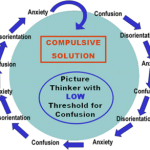Research Topic: Disorientation
Ron Davis developed the Davis programs for dyslexia and other learning challenges based in part on in-house, clinical research of the impact of disorientation on perception. This page contains links to independent research that may inform and expand upon the understanding of these factors.
Research Articles:
Sarah Fishstrom, Philip Capin, Anna-Mari Fall, Gregory Roberts, Amie E. Grills & Sharon Vaughn. Understanding the relation between reading and anxiety among upper elementary students with reading difficulties. Annals of Dyslexia. Published: 16 January 2024, (2024).
Tzipi Horowitz-Kraus, Keri Rosch, Jenny Fotang, Stewart H. Mostofsky, Bradley L. Schlaggar, James Pekar, Nikolay Taran, Rola Farah. Fluent contextual reading is associated with greater synchronization of the visual and auditory networks, fluent reading and better speed of processing in children with dyslexia. Cortex. Available online 17 August 2023, (2023).
Turri, Chiara, Giuseppe Di Dona, Alessia Santoni, Denisa Adina Zamfira, Laura Franchin, David Melcher, and Luca Ronconi. Periodic and Aperiodic EEG Features as Potential Markers of Developmental Dyslexia. Biomedicines. 11, no. 6: 1607, (2023).
John R. Kershner. An Evolutionary Perspective of Dyslexia, Stress, and Brain Network Homeostasis. Frontiers in Human Neuroscience. 14, 575546, (2022).
Engku Mohd Nasri Engku Mat Nasir, Norfaiza Fuad, Mohd Erwandi Marwan, Norfatin Akila. Brainwave Distribution of Cognitive Activities Between Normal and Dyslexia Children. Proceedings of the 6th International Conference on Electrical, Control and Computer Engineering. LNEE, volume 842, (2022).
Catherine Potard, Anne-Charlotte Auger, Stéphanie Lenoir-Perrotel, Christophe Jarry. Examining frustration intolerance beliefs among adults with dyslexia or developmental coordination disorder. Research in Developmental Disabilities. Volume 123, 104184, (2022).
Matthew K Burns, Lisa N. Aguilar, Kristy Warmbold-Brann, June L. Preast, Crystal N. Taylor. Effect of Acquisition Rates On Off-Task Behavior of Kindergarten Students While Learning Sight Words. Psychology in the Schools. 58(1), 5-17, (2021).
D. Dobó, E. Ladányi, Á. Szőllősi, K.S. Lukics, K. Németh & Á. Lukác. The relationship between cognitive control and lexical conflict resolution in developmental dyslexia. Clinical Linguistics & Phonetics. Published online: 02 Dec 2021, (2021).
Julian Q. Kosciessa, Ulman Lindenberger & Douglas D. Garrett. Thalamocortical excitability modulation guides human perception under uncertainty. Nature Communications. 12, Article number: 2430, (2021).
Alexa Meilleur, Nicholas E.V. Foster, Sarah-Maude Coll, Simona M. Brambati, Krista L. Hyde. Unisensory and multisensory temporal processing in autism and dyslexia: A systematic review and meta-analysis. Neuroscience & Biobehavioral Reviews. Available online 13 June 2020, (2020).
Gabay, Y., Gabay, S., Schiff, R., & Henik, A.. Visual and Auditory Interference Control of Attention in Developmental Dyslexia. Journal of the International Neuropsychological Society. 1-11, (2019).
Mettey, A., Bouvier, A., Jooste, V. Boucher, Y., & Quercia, P.. Are changes in the stomatognatic system able to modify the eye balance in dyslexia?. Journal of oral biology and craniofacial research. 9(2), 166–171, (2019).
Raghuram A , Hunter DG , Gowrisankaran S , Waber DP. Self-Reported Visual Symptoms in Children with Developmental Dyslexia.. Vision Research. Volume 155, Pages 11-16, February, (2019).
T.M. Centanni , D. Pantazis, D.T. Truong, J.R. Gruen, J.D.E. Gabrieli, T.P. Hogan. Increased variability of stimulus-driven cortical responses is associated with genetic variability in children with and without dyslexia. Developmental Cognitive Neuroscience. Volume 34, Pages 7-17, November, (2018).
Michael Peer, Ronit Lyon, Shahar Arzy. Orientation and disorientation: Lessons from patients with epilepsy. Epilepsy and Behavior. Volume 41, Pages 149-157,, (2014).
Hornickel, Jane; Nina Kraus. Unstable Representation of Sound: A Biological Marker of Dyslexia. Journal of Neuroscience. 33 (8) 3500-3504, (2013).
Jürgen Bergmann, Florian Hutzler, Wolfgang Klimesch, Heinz Wimmer. How is dysfluent reading reflected in the ERP?. Journal of Neurolinguistics. Volume 18, Issue 2, Pages 153-165, (2005).
David I Shore, Emily Spry, Charles Spence. Confusing the mind by crossing the hands. Cognitive Brain Research. Volume 14, Issue 1, Pages 153-163, (2002).
Jerome S. Bruner, Leo Postman. On the Perception of Incongruity: A Paradigm. Journal of Personality. Volume 18, Issue 2 Pages: 206-223, (1949).
Jerome S. Bruner, Leo Postman. Perception under stress. Psychological Review. 55(6), 314–323, (1948).



